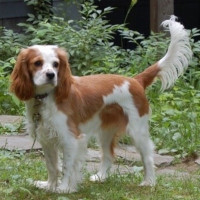Appearance of the Cockalier Spaniel
|
| The appearance of Cockaliers will vary from litter to litter, and it will take some time for the breed to achieve a uniform appearance. For the time being, puppies may resemble one parent more than the other. They tend to have a rather domed skull, with dark, circular eyes that should not protrude, and a relatively long muzzle. Their pendulous ears are densely feathered and hang gently to the side of their faces. Their body is rather robust and rests on short but straight legs. Their tail is of medium length and may have a plume of fur. The Cockalier's coat is highly prized and consists of fine, wavy fur of medium length. Two-tone dogs are common, and color combinations can be brown and white, red and white or black and white. Solid coat colors are also possible and will include red, brown and black. A Cockalier reaches a height of 30 to 35 cm and generally weighs 4.5 to 11 kg. |
Temperament of the Cockalier Spaniel
|
| Because the Cavalier and Cocker Spaniel have such different personalities, the Cockalier's temperament can be difficult to predict. Most dogs are gentle, people-oriented and are happiest when around those they love. They are gentle and patient with children, and rarely, if ever, attack them. Likewise, they get on very well with all other pets and will rarely fight. Although the Cockalier can make an adequate guard dog and barks at the first sign of an intruder, it is simply not hostile enough to make a defense dog and is inclined to welcome new visitors with enthusiasm. Easy to live with, Cockaliers don't tend to be too demanding and will never say no to a game, but don't require constant entertainment. That said, it is not advisable to leave this dog alone for too long, as it can be very dependent on people and can develop separation anxiety if left alone for long periods. |
Needs and activities of the Cockalier Spaniel
|
| Cockaliers need to get out and about to expend some energy and check out all the interesting things in their secure garden. If you walk them, be sure to keep them on a leash, unless the area is secure. Otherwise, they may take off after any small game they smell. Their hunting instinct is always strong, so it's best to be aware of it. Cockaliers are equally at home in an apartment or a house, but they need to go out every day. They adapt well to the city or country, and enjoy a temperate climate. |
Maintenance of the Cockalier Spaniel
|
| The Cockalier's coat will vary depending on whether it more closely resembles its Cavalier King Charles Spaniel parent or follows after its Cocker Spaniel parent. They generally have a coat ranging from the soft Cavalier coat to the more curious Cocker Spaniel. They need regular brushing to make sure their fur isn't sticky, but once or twice a week with a firm bristle brush is fine. The Cockalier will love the attention of the grooming session. Take the opportunity to clean his ears too, check around the eyes and brush his teeth to keep them healthy. Their nails may need trimming, especially if they're indoors - you'll soon know when you hear them making noise on the floor. |









 English (United Kingdom)
English (United Kingdom)